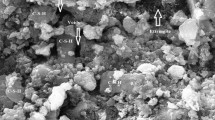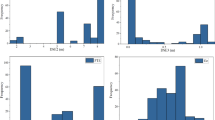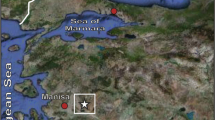Abstract
The present research employed an authentic multivariate dataset of J-CLAY/5/124 Jiangsu clays from China to construct an artificial neural network (ANN) model for the purpose of forecasting the subgrade resilience modulus (Mr) using cone tip resistance (qc), sleeve frictional resistance (fs), natural water content (w), and dry unit weight (gd) as predictors. The dataset underwent exploratory data analysis (EDA) and data preprocessing procedures to ensure data quality and integrity. Subsequently, the artificial neural network (ANN) model underwent training and optimization via the Tabu-Search algorithm. The model’s performance was evaluated using various metrics, namely adjusted R2, R2, MAE, MSE, and RMSE. The artificial neural network (ANN) model that was optimized demonstrated a notable level of precision, as indicated by an adjusted R2 value of 0.87560629 and an R2 value of 0.892192118. The outcomes of the prediction exhibited favourable efficacy with minimal inaccuracies, as demonstrated by the mean absolute error (MAE) of 0.217086317 and the mean squared error (MSE) of 0.071266013. In addition, the utilization of Tabu-Search optimization resulted in a notable enhancement of the model’s efficacy, as evidenced by its elevated levels of recall, precision, F1 score, accuracy, and reduced loss. The ANN model that was developed using Tabu-Search optimization demonstrated encouraging outcomes in forecasting the subgrade resilience modulus of J-CLAY/5/124 Jiangsu clays. This outcome has the potential to offer significant insights for geotechnical engineering applications.








Similar content being viewed by others
Data availability
The data used in this study are available upon request from the corresponding author. The data will be made available in a secure and confidential manner, consistent with applicable laws and regulations. Any requests for data will be reviewed on a case-by-case basis to ensure that the data are being used for legitimate research purposes.
Change history
13 June 2023
A Correction to this paper has been published: https://doi.org/10.1007/s42107-023-00733-y
References
Ahmad, M., Tang, X. W., Qiu, J. N., Ahmad, F., & Gu, W. J. (2021). Application of machine learning algorithms for the evaluation of seismic soil liquefaction potential. Frontiers of Structural and Civil Engineering, 15, 490–505.
Alavi, A. H., Ameri, M., Gandomi, A. H., & Mirzahosseini, M. R. (2011). Formulation of flow number of asphalt mixes using a hybrid computational method. Construction and Building Materials, 25(3), 1338–1355. https://doi.org/10.1016/j.conbuildmat.2010.09.010
Alavi, A. H., Gandomi, A. H., Gandomi, M., & Sadat Hosseini, S. S. (2009). Prediction of maximum dry density and optimum moisture content of stabilised soil using RBF neural networks. The IES Journal A, 2(2), 98–106. https://doi.org/10.1080/19373260802659226
Bardhan, A., & Samui, P. (2022). Probabilistic slope stability analysis of Heavy-haul freight corridor using a hybrid machine learning paradigm. Transportation Geotechnics, 37, 100815.
Cao, M., & Qiao, P. (2007). Neural network committee-based sensitivity analysis strategy for geotechnical engineering problems. Neural Computing and Applications, 17(5–6), 509–519. https://doi.org/10.1007/s00521-007-0143-5
Carvalho, L. O., & Ribeiro, D. B. (2019). Soil classification system from cone penetration test data applying distance-based machine learning algorithms. Soils and Rocks, 42(2), 167–178.
Cevik, A., & Cabalar, A. F. (2009). Modelling damping ratio and shear modulus of sand–mica mixtures using genetic programming. Expert Systems with Applications, 36(4), 7749–7757. https://doi.org/10.1016/j.eswa.2008.09.010
Champi, T. (2021). Slope stability modelling of slurry dams through cone penetration data interpretation
Chen, J., Vissinga, M., Shen, Y., Hu, S., Beal, E., & Newlin, J. (2021). Machine learning–based digital integration of geotechnical and ultrahigh–frequency geophysical data for offshore site characterizations. Journal of Geotechnical and Geoenvironmental Engineering, 147(12), 04021160.
Ching, J. & Phoon, K. K. (2022). Role of generic soil database in site-specific soil property estimation
Demir, S., & Şahin, E. K. (2021). Assessment of feature selection for liquefaction prediction based on recursive feature elimination. Avrupa Bilim Ve Teknoloji Dergisi, 28, 290–294.
Deng, L., Wu, Y., Hu, X., Liang, L., Ding, Y., Li, G., Zhao, G., Li, P., & Xie, Y. (2020). Rethinking the performance comparison between SNNS and Anns. Neural Networks, 121, 294–307. https://doi.org/10.1016/j.neunet.2019.09.005
Duan, W., Congress, S. S., Cai, G., Puppala, A. J., Dong, X., & Du, Y. (2021). Empirical correlations of soil parameters based on piezocone penetration tests (CPTU) for Hong Kong-zhuhai-macau bridge (HZMB) project. Transportation Geotechnics, 30, 100605. https://doi.org/10.1016/j.trgeo.2021.100605
Entezari, I., Sharp, J., & Mayne, P. W. (2022). A data-driven approach to predict shear wave velocity from CPTu measurements. Cone penetration testing 2022 (pp. 374–380). Boca Raton: CRC Press.
Florin Metenidis, M., Witczak, M., & Korbicz, J. (2004). A novel genetic programming approach to nonlinear system modelling: application to the DAMADICS benchmark problem. Engineering Applications of Artificial Intelligence, 17(4), 363–370. https://doi.org/10.1016/j.engappai.2004.04.009
Gandomi, A. H., & Alavi, A. H. (2011a). A new multi-gene genetic programming approach to non-linear system modeling. Part II: geotechnical and earthquake engineering problems. Neural Computing and Applications, 21(1), 189–201. https://doi.org/10.1007/s00521-011-0735-y
Gandomi, A. H., & Alavi, A. H. (2011b). A new multi-gene genetic programming approach to nonlinear system modeling. Part I: materials and structural engineering problems. Neural Computing and Applications, 21(1), 171–187. https://doi.org/10.1007/s00521-011-0734-z
Gao, W., Zhang, Y., Ramanujan, D., Ramani, K., Chen, Y., Williams, C. B., Wang, C. C. L., Shin, Y. C., Zhang, S., & Zavattieri, P. D. (2015). The status, challenges, and future of additive manufacturing in engineering. Computer-Aided Design, 69, 65–89. https://doi.org/10.1016/j.cad.2015.04.001
Hanandeh, S. M., Al-Bodour, W. A., & Hajij, M. M. (2022). A comparative study of soil liquefaction assessment using machine learning models. Geotechnical and Geological Engineering, 40(9), 4721–4734.
Harandizadeh, H. (2020). Developing a new hybrid soft computing technique in predicting ultimate pile bearing capacity using cone penetration test data. Artificial Intelligence for Engineering Design, Analysis and Manufacturing, 34(1), 114–126. https://doi.org/10.1017/s0890060420000025
Hossein Alavi, A., & Hossein Gandomi, A. (2011). A robust data mining approach for formulation of geotechnical engineering systems. Engineering Computations, 28(3), 242–274. https://doi.org/10.1108/02644401111118132
Hossein Alavi, A., Hossein Gandomi, A., Mollahassani, A., Akbar Heshmati, A., & Rashed, A. (2010). Modeling of maximum dry density and optimum moisture content of stabilized soil using artificial neural networks. Journal of Plant Nutrition and Soil Science, 173(3), 368–379. https://doi.org/10.1002/jpln.200800233
Kaveh, A., & Khalegi, A. (1998). Prediction of strength for concrete specimens using artificial neural networks. Advances in engineering computational technology (pp. 165–171). Edinburgh: Civil-Comp Press.
Kaveh, A., & Khavaninzadeh, N. (2023). Efficient training of two Anns using four meta-heuristic algorithms for predicting the FRP strength. Structures, 52, 256–272. https://doi.org/10.1016/j.istruc.2023.03.178
Kaveh, A., Hassani, B., Shojaee, S., & Tavakkoli, S. M. (2008). Structural topology optimization using ant colony methodology. Engineering Structures, 30(9), 2559-2565
Kaveh, A., Khodadadi, N., Azar, B. F., & Talatahari, S. (2020). Optimal design of large-scale frames with an advanced charged system search algorithm using box-shaped sections. Engineering with Computers, 37(4), 2521–2541. https://doi.org/10.1007/s00366-020-00955-7
Kaveh, A., Rahmani, P., & Eslamlou, A. D. (2021). An efficient hybrid approach based on Harris Hawks optimization and imperialist competitive algorithm for structural optimization. Engineering with Computers, 38(S2), 1555–1583. https://doi.org/10.1007/s00366-020-01258-7
Kaveh, A., & Servati, H. (2001). Design of double layer grids using backpropagation neural networks. Computers & Structures, 79(17), 1561–1568.
Khosravi, A., Martinez, A., & DeJong, J. T. (2020). Discrete element model (DEM) simulations of cone penetration test (CPT) measurements and soil classification. Canadian Geotechnical Journal, 57(9), 1369–1387. https://doi.org/10.1139/cgj-2019-0512
Koperska, W., Stachowiak, M., Duda-Mróz, N., Stefaniak, P., Jachnik, B., Bursa, B., & Stefanek, P. (2022). The tailings storage facility (TSF) stability monitoring system using advanced big data analytics on the example of the Żelazny Most Facility. Archives of Civil Engineering, 68(2), 297–311.
Kumar, P., & Samui, P. (2022). Design of an energy pile based on CPT data using soft computing techniques. Infrastructures, 7(12), 169.
Liu, S., Zou, H., Cai, G., Bheemasetti, B. V., Puppala, A. J., & Lin, J. (2016). Multivariate correlation among resilient modulus and cone penetration test parameters of cohesive subgrade soils. Engineering Geology, 209, 128V142. https://doi.org/10.1016/j.enggeo.2016.05.018
Long, J. S., & Ervin, L. H. (2000). Using heteroscedasticity consistent standard errors in the linear regression model. The American Statistician, 54(3), 217–224. https://doi.org/10.1080/00031305.2000.10474549
Majidifard, H., Jahangiri, B., Buttlar, W. G., & Alavi, A. H. (2019). New machine learning-based prediction models for fracture energy of asphalt mixtures. Measurement, 135, 438–451.
Mei, L., & Wang, Q. (2021). Structural Optimization in civil engineering: a literature review. Buildings, 11(2), 66. https://doi.org/10.3390/buildings11020066
Nalawade, R. D., Singh, K. P., Roul, A. K., & Patel, A. (2022). Parametric study and calibration of hysteretic spring and linear cohesion contact models for cohesive soils using definitive screening design. Computational Particle Mechanics. https://doi.org/10.1007/s40571-022-00523-4
Pham, T. A., & Vu, H.-L.T. (2021). Application of ensemble learning using weight voting protocol in the prediction of pile bearing capacity. Mathematical Problems in Engineering, 2021, 1–14. https://doi.org/10.1155/2021/5558449
Pires-Sturm, A. P., & DeJong, J. T. (2023). Cone penetration resistance in coarse-grained gravelly soils. Journal of Geotechnical and Geoenvironmental Engineering. https://doi.org/10.1061/(asce)gt.1943-5606.0002934
Robertson, P. K. (2016). Cone penetration test (cpt)-based soil behaviour type (SBT) classification system—An update. Canadian Geotechnical Journal, 53(12), 1910–1927. https://doi.org/10.1139/cgj-2016-0044
Rusek, J., Tajduś, K., Firek, K., & Jędrzejczyk, A. (2021). Score-based Bayesian belief network structure learning in damage risk modelling of mining areas building development. Journal of Cleaner Production, 296, 126528.
Sattari, F., Macciotta, R., Kurian, D., & Lefsrud, L. (2021). Application of Bayesian network and artificial intelligence to reduce accident/incident rates in oil & gas companies. Safety Science, 133, 104981.
Shahin, M. A., Jaksa, M. B., & Maier, H. R. (2001). Artificial neural network applications in geotechnical engineering. Australian Geomechanics, 36(1), 49–62.
Spagnoli, G., & Collico, S. (2023). Multivariate analysis of a grouted sand with colloidal silica at different dilution stages. Transportation Geotechnics, 40, 100987. https://doi.org/10.1016/j.trgeo.2023.100987
Tsai, C.-C., Kishida, T., & Kuo, C.-H. (2019). Unified correlation between SPT–N and shear wave velocity for a wide range of soil types considering strain-dependent behavior. Soil Dynamics and Earthquake Engineering, 126, 105783. https://doi.org/10.1016/j.soildyn.2019.105783
Vasegh, M., Dehghanbanadaki, A., & Motamedi, S. (2023). Enhanced soil liquefaction potential estimation using machine learning and web-based platform
Zeng, J., Roy, B., Kumar, D., Mohammed, A. S., Armaghani, D. J., Zhou, J., & Mohamad, E. T. (2021). Proposing several hybrid PSO-extreme learning machine techniques to predict TBM performance. Engineering with Computers. https://doi.org/10.1007/s00366-020-01225-2
Zhang, W. G., & Goh, A. T. C. (2013). Multivariate adaptive regression splines for analysis of geotechnical engineering systems. Computers and Geotechnics, 48, 82–95. https://doi.org/10.1016/j.compgeo.2012.09.016
Zhang, W., Li, H., Li, Y., Liu, H., Chen, Y., & Ding, X. (2021). Application of deep learning algorithms in geotechnical engineering: a short critical review. Artificial Intelligence Review, 54, 1–41.
Zhang, H., Feng, H., Hewage, K., & Arashpour, M. (2022). Artificial neural network for predicting building energy performance: a surrogate energy retrofits decision support framework. Buildings, 12(6), 829.
Funding
The authors did not receive support from any organization for the submitted work.
Author information
Authors and Affiliations
Contributions
MA and MB wrote the main manuscript text and prepared figures . All authors wrote and reviewed the manuscript.
Corresponding author
Ethics declarations
Conflict of interest
All authors certify that they have no affiliations with or involvement in any organization or entity with financial interest or non- financial interest in the subject matter or materials discussed in this manuscript.
Additional information
Publisher's Note
Springer Nature remains neutral with regard to jurisdictional claims in published maps and institutional affiliations.
The original online version of this article was revised: The name of the second author was not correct
Rights and permissions
Springer Nature or its licensor (e.g. a society or other partner) holds exclusive rights to this article under a publishing agreement with the author(s) or other rightsholder(s); author self-archiving of the accepted manuscript version of this article is solely governed by the terms of such publishing agreement and applicable law.
About this article
Cite this article
Al Khazaleh, M., Bisharah, M. ANN-based prediction of cone tip resistance with Tabu-Search optimization for geotechnical engineering applications. Asian J Civ Eng 24, 3037–3054 (2023). https://doi.org/10.1007/s42107-023-00693-3
Received:
Accepted:
Published:
Issue Date:
DOI: https://doi.org/10.1007/s42107-023-00693-3




